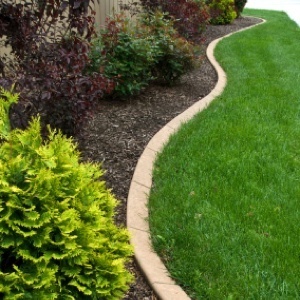 Landscape edging is a great way to create clean, well-defined borders between garden spaces, and give your garden a finished appearance. It's also functional-keeping grass out of your plants, while keeping soil, rocks, and mulch from spilling into your lawn.
Landscape edging is a great way to create clean, well-defined borders between garden spaces, and give your garden a finished appearance. It's also functional-keeping grass out of your plants, while keeping soil, rocks, and mulch from spilling into your lawn.
When it comes to selecting edging materials, there are several things to consider: the overall look you are trying to achieve, material costs, installation time, and maintenance issues, such as mowing.
With its timeless natural beauty, concrete, stone, or brick edging can make a strong visual impact around garden beds. The upfront costs are higher, but the strength and durability of these materials will last a lifetime. There are also unlimited sizes, colors, and styles to choose from, making it easy to find materials that will compliment your homes exterior. Materials are not dug as deeply into the ground as other types of edging, so if not tightly interlocked or mortared together, grass and weeds may eventually sneak through the cracks and take up residence into your garden beds.
Durability: Lasts a lifetime.
Considerations: Reusable molds are available that allow do-it-yourselfers to create customized edgings in a variety of patterns and colors using fast drying cement. If you have a large area to cover, you may want to purchase 2-4 molds to speed up production.
Durability: Aluminum and galvanized steel will last nearly forever.
Considerations: Steel edging may be affected by frost heaves and unless galvanized, is susceptible to rust. Aluminum edging does not rust.
Durability: Very durable-varies some according to type. Some plastics may become brittle after long-term exposure to sun and extreme temperatures.
Considerations: Sharp, crisp corners are difficult to obtain using plastic edging, and certain types need to be securely anchored with stakes to keep them from popping out of the ground. When possible, consider using recycled plastic products. They never biodegrade and can be recycled again if you ever decide you no longer want them.
Durability: Durable-depending on the wood. Redwood, cedar, and cypress are naturally rot resistant, but are more expensive than other type of wood. Damage caused by insects can be problematic in certain areas.
Considerations: Avoid pressure treated wood or wood that is covered in creosote (railroad ties). Over time, they can leach chemicals into the soil that can harm both plants and beneficial insects.
Durability: Varies depending on the life of the plants.
Considerations: Plants are a great way to soften hard edges. Although beautiful, "living" edgings are not effective in preventing grass from infiltrating into garden beds and they require constant care and maintenance.
Measuring: Once you decide where to install your edging, use a garden hose or string to mark off the area, then measure how many feet of edging you will need to buy.
Digging: To keep grass and plant roots contained to their respective sides of your edging, always dig a trench that is at least 4 to 6 inches deep and slightly wider than your edging requires. For shrubs and hedges with deeper roots, dig down ever deeper-2 feet or more.
Installation: Install your edging when the soil is dry. Heavy rain can cause the ground to swell and cause edging to shift once it dries. Sink flush edging into the ground vertically until it sits a half-inch (or less) above the ground. Using a rubber hammer, drive stakes into the ground every few feet to secure the edging in place. To level concrete and brick edging, spread a thin layer of sand into the trench to create an even surface. Stone edging can be dug into the ground at the desired height.
Fill any gaps: Once your edging is in, use soil to backfill any gaps or holes along the edges.
This page contains the following solutions.
A really frugal edging for gardens is broken concrete. When we had our bathroom floor re-done, a pile of light concrete sat outside our house for about 2 months before I got tired of waiting for them to haul it away.
I save my vegetable cans, clean them and take the paper off of them and use them for starting new plants and as a border around my gardens. When I put them around garden, I spray paint them in different colors and turn them upside down and use a hammer to bang into ground. By doing this, it saves it from the landfill and i get free garden edging that looks great
Here are the questions asked by community members. Read on to see the answers provided by the ThriftyFun community.
I want to recycle quite a lot of clay roof tiles for use in my landscape. Any ideas?
Jeanne from Cortez, CO
You could make alot of things out of them, how much time do you have? lol. You could make a fire place, bird house, bird bath, Koi pond, A path way, or just some garden edging. Hope this helps. Try to have fun with this one!
How about making a (Sun flower) flower pattern out of them for a sitting area. Or a sun dial ? Planting camomile or other herbs that smell nice when stepped on around it?
GG Vi
I wish you lived near me! I would take them off your hands and use them for garden edging.
How about using them as a garden edging?